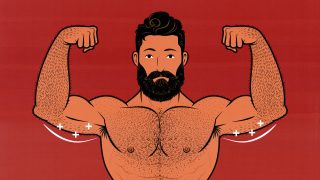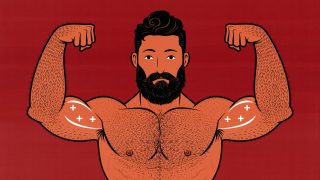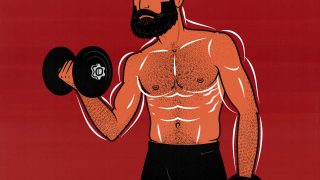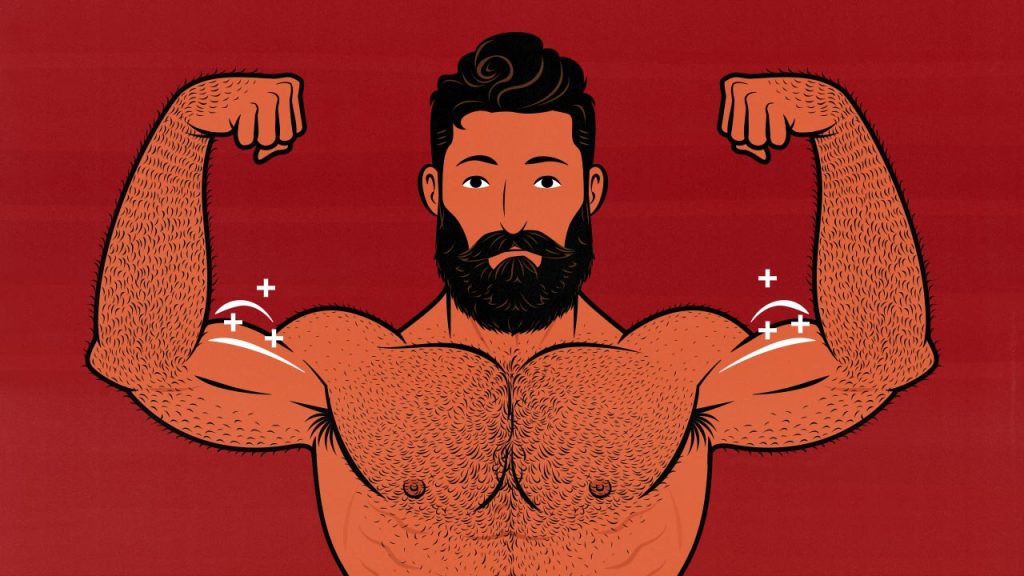
The Best Long Head Biceps Exercises
The main function of your biceps is to flex your arms. That’s what biceps curls are for. But the long head of your biceps also helps to stabilize the shoulder joint, meaning:
- Regular dumbbell, barbell, and cable biceps curls train the long head just fine. There’s no movement at the shoulder joint, so there’s no problem.
- Drag curls, chin-ups, pull-ups, and rows have too much movement at the shoulder joint, preventing the long head from working properly.
- Exercises that keep your elbows behind your body train the long head at longer muscle lengths, which is fantastic for building muscle (full explanation).
- Exercises that keep your elbows in front of your body train the long head at shorter muscle lengths, which isn’t very good for building muscle.
- Exercises that are hard at the bottom are better for building muscle than exercises that are harder at the top (full explanation).
If you want to keep it simple, keep doing regular biceps curls (tutorial video). They’re great for both the short and long heads of your biceps. It doesn’t have to be more complicated than that.
But we can go deeper. If you bring your elbows behind your body and challenge your biceps at the bottom of the range motion, the long head of your biceps will get a tremendous muscle-building stimulus. There are two exercises that take advantage of that.
The Anatomy of Biceps Training
Your biceps have two heads. The short head sits on the inside of your arm, and the long head lies on the outside. Bodybuilders like to say the short head gives your biceps width, and the long head gives the peak.
You can fully stretch the long head of your biceps by opening your arms, bringing your elbows behind your body, and twisting your palms to face backwards. You don’t need to worry about the movement at your wrist, but it helps to fully open your arms and shoulders at the bottom of the range of motion.
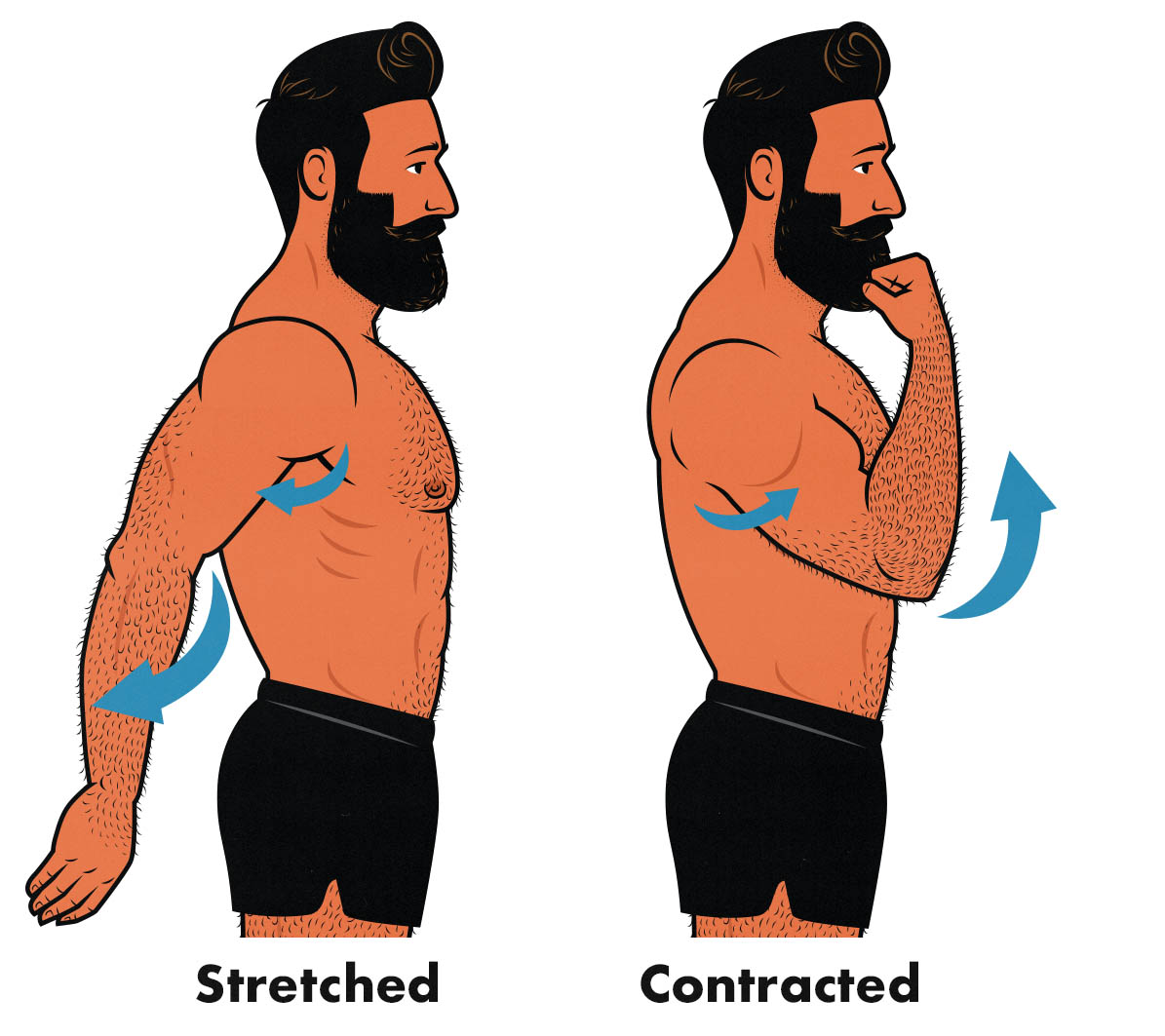
Then, to contract the long head, you can flex your arms, bring your elbow in front of your body, and twist your palms up to face you. You don’t really need to worry about fully contracting your biceps, though. It’s the deep part of the range of motion that matters.
Finally, the main function of your biceps is to flex your arms. That’s where it has the best leverage. That’s when it will work the hardest. So, we want an exercise that trains elbow flexion. We want some sort of biceps curl.
That means the best exercise for the long head of your biceps is a biceps curl that has your elbows behind your body. Even better if it’s hard at the bottom of the range of motion. There are two exercises that are perfect for that.
How to Emphasize the Biceps Long Head
Bodybuilders have their ways of focusing on the long head. You’ll hear advice like keeping your elbows close to your body, using a narrow grip, and doing hammer curls. I’m not sure any of those actually help. There’s never any evidence given, and I’m not sure why it would be true.
However, there’s quite a lot of evidence showing that muscles that cross multiple joints work harder and grow faster—twice as fast—when we stretch them at the secondary joint (study, study). In this case, the main joint is your elbow joint, so you’d want to stretch your biceps long head at the shoulder joint.
Best: Lying Dumbbell Biceps Curls
Lying biceps curls are the best long head biceps exercise. They’re hardest near the bottom of the range of motion and train the long head under a full stretch.
To do them, you lie down on a bench, bring your elbows behind your body, and curl the weight up. They’re fantastic for the long head and have no real downside. Just make sure the exercise feels good on your shoulder joint. Not everyone has enough shoulder mobility to do these comfortably.
They might look a little strange, but they’re a traditional exercise, and they’ve started becoming popular lately. I’ve seen them recommended by Alex Leonidas, Kassem Hanson, and Mike Israetel.
Alternative: Bayesian Biceps Curls
Bayesian cable curls are just like lying biceps curls, but you need a cable machine, and they aren’t as stable. The cable will pull you backwards, making it harder to focus on your biceps. I prefer the lying dumbbell variation, but some people swear by these. Menno Henselmans and Jeff Nippard in particular. I think it’s Menno’s creation, so I’ll put his tutorial here:
To get the best strength curve, you’d set up the cable stack behind you, with the cable pulling back. That might pull you over, though, so most people aim the cable diagonally down and back.
The Problem With Incline & Preacher Curls
Incline curls work your biceps long head at longer muscle lengths, which is great, but they aren’t hard at the bottom of the range of motion. This makes them pretty good for the long head, but not the best overall biceps exercise.
Preacher curls work your biceps harder at the bottom of the range of motion, but your elbows are in front of your body, so they work the long head at shorter muscle lengths. That means they aren’t particularly good for your long head, but they’re incredible for the short head.
Alright, that’s it for now. If you want a balanced biceps workout routine, check out this article.

If you’re eager to gain your first 20–30 pounds of muscle, check out our Bony to Beastly (men’s) program or Bony to Bombshell (women’s) program. Both use full-body workout routines. If you’re an intermediate lifter, check out our Outlift Intermediate Bulking Program. It includes 3-day, 4-day, and 5-day workout routines. Both programs include online coaching.



